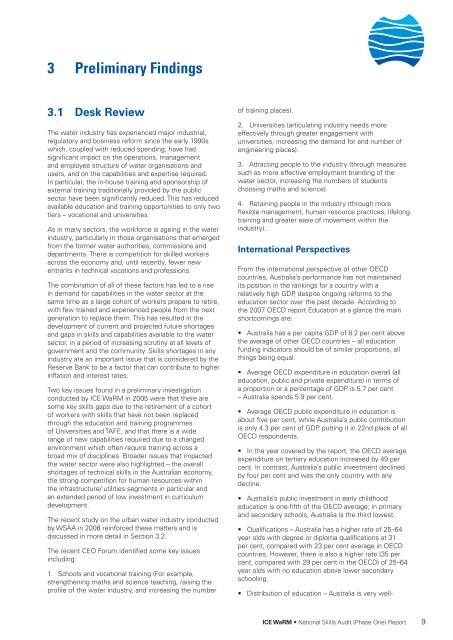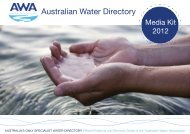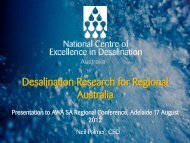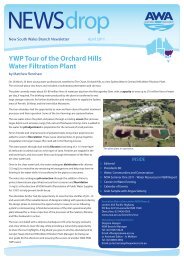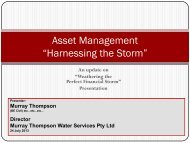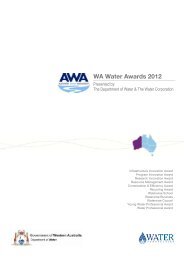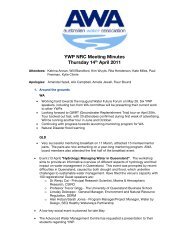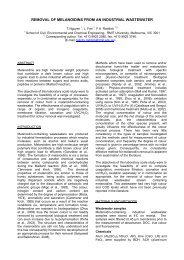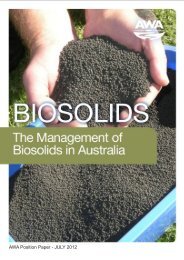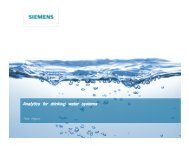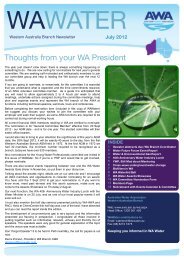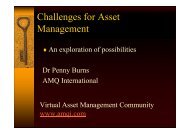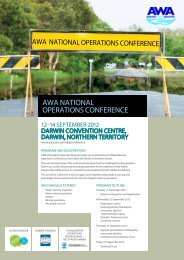National Water Skills Audit - Australian Water Association
National Water Skills Audit - Australian Water Association
National Water Skills Audit - Australian Water Association
- No tags were found...
Create successful ePaper yourself
Turn your PDF publications into a flip-book with our unique Google optimized e-Paper software.
3 Preliminary Findings3.1 Desk ReviewThe water industry has experienced major industrial,regulatory and business reform since the early 1990swhich, coupled with reduced spending, have hadsignificant impact on the operations, managementand employee structure of water organisations andusers, and on the capabilities and expertise required.In particular, the in-house training and sponsorship ofexternal training traditionally provided by the publicsector have been significantly reduced. This has reducedavailable education and training opportunities to only twotiers – vocational and universities.As in many sectors, the workforce is ageing in the waterindustry, particularly in those organisations that emergedfrom the former water authorities, commissions anddepartments. There is competition for skilled workersacross the economy and, until recently, fewer newentrants in technical vocations and professions.The combination of all of these factors has led to a risein demand for capabilities in the water sector at thesame time as a large cohort of workers prepare to retire,with few trained and experienced people from the nextgeneration to replace them. This has resulted in thedevelopment of current and projected future shortagesand gaps in skills and capabilities available to the watersector, in a period of increasing scrutiny at all levels ofgovernment and the community. <strong>Skills</strong> shortages in anyindustry are an important issue that is considered by theReserve Bank to be a factor that can contribute to higherinflation and interest rates.Two key issues found in a preliminary investigationconducted by ICE WaRM in 2005 were that there aresome key skills gaps due to the retirement of a cohortof workers with skills that have not been replacedthrough the education and training programmesof Universities and TAFE; and that there is a widerange of new capabilities required due to a changedenvironment which often require training across abroad mix of disciplines. Broader issues that impactedthe water sector were also highlighted – the overallshortages of technical skills in the <strong>Australian</strong> economy,the strong competition for human resources withinthe infrastructure/ utilities segments in particular andan extended period of low investment in curriculumdevelopment.The recent study on the urban water industry conductedby WSAA in 2008 reinforced these matters and isdiscussed in more detail in Section 3.2.The recent CEO Forum identified some key issuesincluding:1. Schools and vocational training (For example,strengthening maths and science teaching, raising theprofile of the water industry, and increasing the numberof training places).2. Universities (articulating industry needs moreeffectively through greater engagement withuniversities, increasing the demand for and number ofengineering places).3. Attracting people to the industry (through measuressuch as more effective employment branding of thewater sector, increasing the numbers of studentschoosing maths and science).4. Retaining people in the industry (through moreflexible management, human resource practices, lifelongtraining and greater ease of movement within theindustry).International PerspectivesFrom the international perspective of other OECDcountries, Australia’s performance has not maintainedits position in the rankings for a country with arelatively high GDP, despite ongoing reforms to theeducation sector over the past decade. According tothe 2007 OECD report Education at a glance the mainshortcomings are:• Australia has a per capita GDP of 8.2 per cent abovethe average of other OECD countries – all educationfunding indicators should be of similar proportions, allthings being equal.• Average OECD expenditure in education overall (alleducation, public and private expenditure) in terms ofa proportion or a percentage of GDP is 5.7 per cent– Australia spends 5.9 per cent.• Average OECD public expenditure in education isabout five per cent, while Australia’s public contributionis only 4.3 per cent of GDP, putting it in 22nd place of allOECD respondents.• In the year covered by the report, the OECD averageexpenditure on tertiary education increased by 49 percent. In contrast, Australia’s public investment declinedby four per cent and was the only country with anydecline.• Australia’s public investment in early childhoodeducation is one-fifth of the OECD average; in primaryand secondary schools, Australia is the third lowest.• Qualifications – Australia has a higher rate of 25–64year olds with degree or diploma qualifications at 31per cent, compared with 23 per cent average in OECDcountries. However, there is also a higher rate (35 percent, compared with 29 per cent in the OECD) of 25–64year olds with no education above lower secondaryschooling.• Distribution of education – Australia is very well-ICE WaRM • <strong>National</strong> <strong>Skills</strong> <strong>Audit</strong> (Phase One) Report


